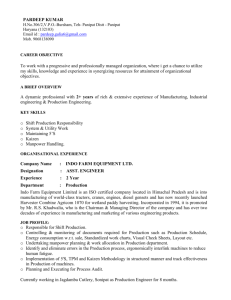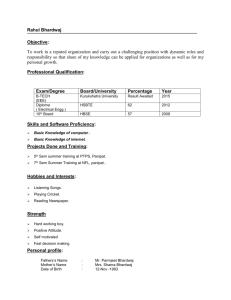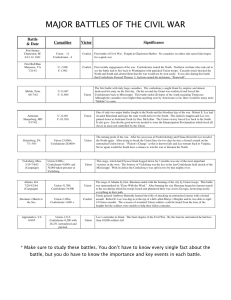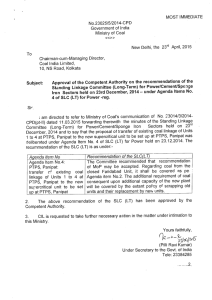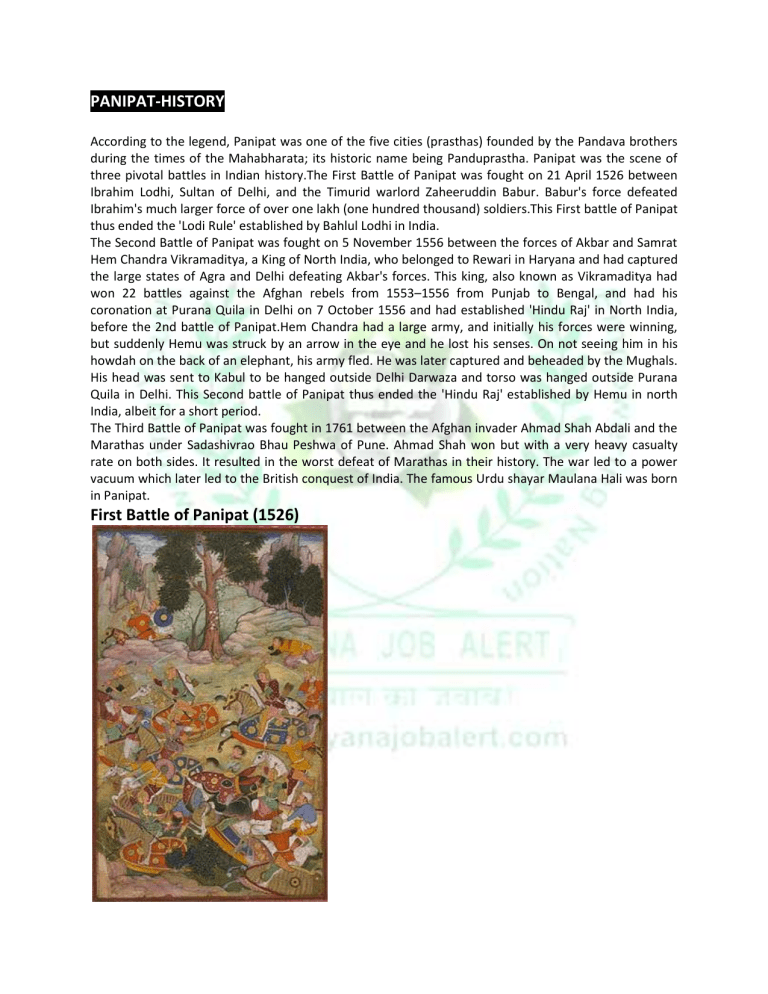
PANIPAT-HISTORY According to the legend, Panipat was one of the five cities (prasthas) founded by the Pandava brothers during the times of the Mahabharata; its historic name being Panduprastha. Panipat was the scene of three pivotal battles in Indian history.The First Battle of Panipat was fought on 21 April 1526 between Ibrahim Lodhi, Sultan of Delhi, and the Timurid warlord Zaheeruddin Babur. Babur's force defeated Ibrahim's much larger force of over one lakh (one hundred thousand) soldiers.This First battle of Panipat thus ended the 'Lodi Rule' established by Bahlul Lodhi in India. The Second Battle of Panipat was fought on 5 November 1556 between the forces of Akbar and Samrat Hem Chandra Vikramaditya, a King of North India, who belonged to Rewari in Haryana and had captured the large states of Agra and Delhi defeating Akbar's forces. This king, also known as Vikramaditya had won 22 battles against the Afghan rebels from 1553–1556 from Punjab to Bengal, and had his coronation at Purana Quila in Delhi on 7 October 1556 and had established 'Hindu Raj' in North India, before the 2nd battle of Panipat.Hem Chandra had a large army, and initially his forces were winning, but suddenly Hemu was struck by an arrow in the eye and he lost his senses. On not seeing him in his howdah on the back of an elephant, his army fled. He was later captured and beheaded by the Mughals. His head was sent to Kabul to be hanged outside Delhi Darwaza and torso was hanged outside Purana Quila in Delhi. This Second battle of Panipat thus ended the 'Hindu Raj' established by Hemu in north India, albeit for a short period. The Third Battle of Panipat was fought in 1761 between the Afghan invader Ahmad Shah Abdali and the Marathas under Sadashivrao Bhau Peshwa of Pune. Ahmad Shah won but with a very heavy casualty rate on both sides. It resulted in the worst defeat of Marathas in their history. The war led to a power vacuum which later led to the British conquest of India. The famous Urdu shayar Maulana Hali was born in Panipat. First Battle of Panipat (1526) The First Battle of Panipat was fought between the invading forces of Babur and the Lodi Empire, which took place on 21 April 1526 in North India. It marked the beginning of the Mughal Empire. This was one of the earliest battles involving gunpowderfirearms and field artillery. Details In 1526, the Mughal forces of Babur, the Timurid ruler of Kabulistan, defeated the much larger ruling army of Ibrahim Lodi,Sultan of Delhi. The battle was fought on 21 April near the small village of Panipat, in the present day Indian state of Haryana, an area that has been the site of a number of decisive battles for the control of Northern India since the twelfth century. It is estimated that Babur's forces numbered around 15,000 men and had between 20 to 24 pieces of field artillery. Babur estimated Lodi had around 100,000 men, though that number included camp followers, while the fighting force was around 30,000 to 40,000 men in total, along with at least 1000 war elephants. Advantage of cannons in the battle It is generally held that Babur's guns proved decisive in battle, firstly because Ibrahim Lodi lacked any field artillery, but also because the sound of the cannon frightened Lodi's elephants, causing them to trample Lodi's own men. However a reading of the contemporary sources show that more than the gun, it was the tactics which helped in winning the day. The new war tactics introduced by Babur were the tulughma and the araba. Tulughma meant dividing the whole army into various units, viz. the Left, the Right and the Centre. The Left and Right divisions were further subdivided into Forward and Rear divisions. Through this a small army could be used to surround the enemy from all the sides. the Centre Forward division was then provided with carts (araba) which were placed in rows facing the enemy and tied to each other with animal hide ropes. Behind them were placed cannons protected and supported by mantelets which could be used to easily manoeuvre the canons. These two tactics made Babur's artillery lethal. The guns and cannons could be fired without any fear of being hit as they were shielded by the bullock carts which were held in place due to the hide ropes holding them together. the nozzle of the heavy cannons could also be easily changed as they could be manoeuvered by the mantelets which were provided with wheels. Ibrahim Lodi died on the field of battle, abandoned by his feudatories and generals (many of whom were mercenaries). Most of them changed their allegiance to the new master of Delhi. However had Sultan Ibrahim survived another hour of fighting he would have won, as Babur had no reserves and his troops were rapidly tiring. Second Battle of Panipat (1556) The Second Battle of Panipat was fought between the forces of Samrat Hem Chandra Vikramaditya, popularly calledHemu, the Hindu king who was ruling North India from Delhi, and the army of Akbar, on November 5, 1556. It was a decisive victory for Akbar's generals Khan Zaman I and Bairam Khan. Background On January 24, 1556, the Mughal ruler Humanyun died in Delhi and was succeeded by his son, Akbarat Kalanaur, who was only thirteen years old. On February 14, 1556, Akbar was enthroned as the king. At the time of his accession to the throne, the Mughal rule was confined to Kabul, Kandahar, parts ofDelhi and Punjab. Akbar was then campaigning in Kabul with his guardian, Bairam Khan. Samrat Hem Chandra Vikramaditya or Hemu was a Hindu emperor in Delhi by virtue of defeating Akbar/Humanyun's army in Battle for Delhi. Hemu belonged to Rewari in present day Haryana, who earlier was an adviser to Sher Shah Suri's son Islam Shah from 1545 to 1553. Hemu had won 22 battles, as Prime Minister and Chief of Army of Islam Shah, during 1553 to 1556 to quell the rebellion by Afghan rebels against Sur regime. At the time of Humayun's death in January 1556, Hemu had just quelled a rebellion in Bengal, killing the Bengal ruler Muhammad Shah in the war. He made his intentions of winning Delhi for himself known to his commanders. He then started a campaign, winning battles throughout northern India. When he attacked Agra, the commander of Akbar's forces inAgra, fled without fighting. A large area of Etawah, Kalpi, and Agra provinces comprising present day Bihar and UP came under Hemu's control. In the Gwalior Fort Hemu consolidated his army by recruiting more Hindus. Hemu then moved towards Delhi and stationed his forces outside the city at Tughlaqabad. On October 6, 1556, army encountered Mughal resistance. After a fierce fight Akbar's forces were ousted, and Tardi Beg, the commander of the Mughal forces, escaped, allowing Hemu to capture Delhi. Around 3,000 Mughals were killed. Hemu was crowned at Purana Qila on October 7, 1556, and established Hindu rule in North India, after 350 years of Muslim rule, and was bestowed the title of Samrat Hem Chandra Vikramaditya. According to Abul Fazl in Akbarnama, Hemu was preparing for an attack on Kabul and made several changes in his army. Battle Developments in Delhi and Agra disturbed the Mughals at Kalanaur, Punjab. Many Mughal Generals advised Akbar to retreat to Kabul as Mughal forces may not face Hemu's might and new awareness among Hindus to liberate their country, but Bairam Khan decided in favor of war. Akbar's army marched towards Delhi. On November 5, both armies met at the historic battlefield of Panipat, where, thirty years earlier, Akbar's grandfather Babur had defeated Ibrahim Lodi in what is now known as the First Battle of Panipat. H.G.Keen writes; "Akbar and his guardian Bairam Khan did not participate in the battle and were stationed 5 Kos (8 miles) away from the war zone. Bairam Khan did not permit the 13 year old child King to be present in battle field in person, instead he was provided with a special guard of 5000 well trained and most faithful troops and was stationed at a safe distance far behind the battle lines. He was instructed by Bairam Khan to flee towards Kabul for life in case the Mughal Army was routed in the battlefield."[3] Hemu led his army himself. Hemu's army consisted of 1500 war elephants and a vanguard of artillery park. Hemu marched in excellent order with 30,000 practiced horsemen composed of Rajputs and Afghans who on many occasions, had by their exploits increased the pride and arrogance. In order to hearten the soldiers and the Afghan Amirs, Hemu had given gifts of lands, and opened the doors of his treasures. Thus he mobilised the valiant fighters. According to Badaoni, Hemu's army was dispirited, and who set all his hopes on the elephants, surrounded by his chiefs charged the imperial hosts, and threw both right and left wings in to great confusion. The Mughal forces were charged repeatedly by elephants to break their lines. The Mughal Vanguard according to sources consisted of 10,000 cavalry, out of which 5000 were experienced veteran soldiers and they got ready to meet the advancing army of Hemu. Hemu was himself commanding his forces from atop an elephant. It seemed Hemu was on a winning track and Akbar's army would rout. Abul Fazl has described the war as quote "Two armies so collided that they struck fire out of water, You'd say the air was all crimsoned. Their steel had all become solid rubies" suddenly in the midst of the contest, an arrow from the bend bow of divener wrath reached Hemu's eye, and piercing the socket, came out at the back of his head. In the words of Badaoni too, "suddenly the arrow of death which no shield can ward off struck his (Hemu) squinting eye so that his brain passed clean out from the cup of his head, and he became unconscious and not to be seen in his Howda. Not seeing Hemu in his howda, Hemu’s army was in disarray and defeated in the ensuing confusion. Several hours after the war ended, dead Hemu was located and captured by Shah Quli Khan Mahram and brought to Akbar’s tent in the camp located at village Saudhapur in Panipat (Located on Panipat-Jind road, 5 km from NH1). General Bairam Khan was desirous that Akbar should slay the hindu king Hemu himself and should establish his right to the title of “Ghazi” (Champion of Faith or war veteran). But Akbar, refused to strike a blood soaked and dead enemy but smote the dead body, just to be called a Ghazi. Bairam Khan irritated by Akbar’s scruples beheaded the king himself. Hemu's supporters constructed a Cenotaph at the site of his beheading, which still exists at the village Saudhapur, on Jind Road at Panipat. Third Battle of Panipat (1761) The Third Battle of Panipat took place on 14 January 1761, at Panipat, about 60 miles (95.5 km) north of Delhi between a northern expeditionary force of the Maratha Empire and a coalition of the King of Afghanistan, Ahmad Shah Durrani with two Indian Muslim allies—the Rohilla Afghans of the Doab, and Shuja-ud-Daula, the Nawab of Oudh. Militarily, the battle pitted the French-supplied artillery[4] and cavalry of the Marathas against the heavy cavalry and mounted artillery(zamburak and jizail) of the Afghans and Rohillas led by Ahmad Shah Durrani and Najib-ud-Daulah, both ethnic Pashtuns (the former is also known as Ahmad Shah Abdali). The battle is considered one of the largest fought in the 18th century,[5] and has perhaps the largest number of fatalities in a single day reported in a classic formation battle between two armies. The decline of the Mughal Empire following the 27-year Mughal-Maratha war (1680–1707) had led to rapid territorial gains for the Maratha Empire. Under Peshwa Baji Rao, Gujarat and Malwa came under Maratha control. Finally, in 1737, Baji Rao defeated the Mughals on the outskirts of Delhi, and brought much of the former Mughal territories south of Delhi under Maratha control. Baji Rao's son, Balaji Baji Rao (popularly known as Nana Saheb), further increased the territory under Maratha control by invading Punjab in 1758. This brought the Marathas into direct confrontation with the Durrani empire of Ahmad Shah Abdali. In 1759 he raised an army from the Pashtun tribes and made several gains against the smaller Maratha garrisons in Punjab. He then joined with his Indian allies—the Rohilla Afghans of the Gangetic Doab—forming a broad coalition against the Marathas. The Marathas, under the command of Sadashivrao Bhau, responded by gathering an army of between 45,000–60,000, which was accompanied by roughly 200,000 non-combatants, a number of whom were pilgrims desirous of making pilgrimages to Hindu holy sites in northern India. The Marathas started their northward journey from Patdur on the 14th of March, 1760. Both sides tried to get the Nawad of Awadh, Shuja-ud-Daulah, into their camp. By late July, Shuja-ud-Daulah made the decision to join the Afghan-Rohilla coalition, preferring to join what was perceived as the 'army of Islam'. This was strategically a major loss for the Marathas, since Shuja provided much needed finances for the long Afghan stay in North India. It is doubtful whether the Afghan-Rohilla coalition would have the means to continue their conflict with the Marathas without Shuja's support. The slow-moving Maratha camp finally reached Delhi on the 1st of August, 1760, and took the city the next day. There followed a series of skirmishes along the banks of the river Yamuna, and a battle at Kunjpura, which the Marathas won against an Afghan garrison of about 15,000 (at this time, Abdali and the other Afghan forces were on the eastern side of the Yamuna river). However, Abdali daringly crossed the river Yamuna on the 25th of October at Baghpat, cutting off the Maratha camp from their base in Delhi. This eventually turned into a two-month-long siege led by Abdali against the Marathas in the town of Panipat. During the siege both sides tried to cut off the other's supplies. At this the Afghans were considerably more effective, so that by the end of November 1760 they had cut off almost all food supplies into the besieged Maratha camp (which had about 250,000 to 300,000, most of whom were non-combatants). According to all the chronicles of the time, food in the Maratha camp ran out by late December or early January and cattle died by the thousands. Reports of soldiers dying of starvation began to be heard in early January. On the 13th of January the Maratha chiefs begged their commander, Sadashiv Rao Bhau, to be allowed to die in battle than perish by starvation. The next day the Marathas left their camp before dawn and marched south towards the Afghan camp in a desperate attempt to break the siege. The two armies came face-to-face around 8:00 a.m., and the battle raged until evening. The specific site of the battle itself is disputed by historians, but most consider it to have occurred somewhere near modern-day Kaalaa Aamb and Sanauli Road. The battle lasted for several days and involved over 125,000 troops. Protracted skirmishes occurred, with losses and gains on both sides. The forces led by Ahmad Shah Durrani came out victorious after destroying several Maratha flanks. The extent of the losses on both sides is heavily disputed by historians, but it is believed that between 60,000–70,000 were killed in fighting, while the numbers of injured and prisoners taken vary considerably. According to the single best eye-witness chronicle- the bakhar by Shuja-ud-Daulah's Diwan Kashi Raj, about 40,000 Maratha prisoners were slaughtered in cold blood the day after the battle.[3] Grant Duff includes an interview of a survivor of these massacres in his History of the Marathas and generally corroborates this number. Shejwalkar, whose monographPanipat 1761 is often regarded as the single best secondary source on the battle, says that "not less than 100,000 Marathas (soldiers and non-combatants) perished during and after the battle. The result of the battle was the halting of further Maratha advances in the north, and a destabilization of their territories, for roughly 10 years. This period of 10 years is marked by the rule of Peshwa Madhavrao, who is credited with the revival of Maratha domination following the defeat at Panipat. In 1771, 10 years after Panipat, he sent a large Maratha army into North India in an expedition that was meant to (a) re-establish Maratha domination in North India, and (b) Punish refractory powers that had either sided with the Afghans, such as the Rohillas, or had shaken off Maratha domination after Panipat. The success of this campaign can be seen as the last saga of the long story of Panipat. Geographical Status Panipat is located at 29.39°N 76.97°E. It has an average elevation of 219 metres (718 feet). Panipat is situated on Shershah Suri Marg (now known as G.T. road or NH-1), 90 KM north of Delhi. On three sides, Panipat district boundaries touch other districts of Haryana –Karnal in the north, Jind in the west and Sonipat in the south. Panipat district borders the state of Uttar Pradesh across the Yamuna river in the east. Panipat was a part of Karnal district until 31 October 1989. It was separated from Karnal, along with another subdivision, the Assandh tehsil. When the district was re-formed on 1 January 1992, the Assandh tehsil was excluded. The newly constructed flyover across the Grand Trunk Road completed in the year 2008 is one of the longest flyovers in India. Climate The region of Panipat experiences three seasons through the year, and these are the seasons of summer, winter and monsoon. The place experiences a tropical climate, and summers in Panipat are very hot while winters are extremely cold. Summers in the town of Panipat are very hot and dry. Temperatures reach a maximum of forty five degrees (45°C) and a minimum of thirty five degrees (35°C) during this time. Late March, April and May are the summer months. Panipat experiences moderate rainfall due to the influence of the South West monsoon. The rainfall is normally mild during the months of July and August and recedes through the month of September. Temperatures during this time fall by a significant level. Winters in the town of Panipat are very cold and dry. The maximum temperature during the winter months will be around seventeen degrees (17°C) and the minimum temperature will be around four degrees (4°C). October, November, December and January are the winter months. TOURIEST PLACES Panipat is a well known destination in the Indian state of Haryana. This town is an important tourist destination mainly because of its strong historical connection and countless monuments. The town of Panipat is a tourist stronghold, and there are many forts and temples that you can visit during your trip to this town. The Panipat museum is one of the chief attractions in the region, and this museum houses many must see pieces of contemporary art and craft. While in the town of Panipat, you can also visit the Old Fort, which is an ancient fort that is in ruins now. A part of this fort has been decently maintained, and it attracts history buffs from all across the country. You can also visit the Kabuli Shah Mosque, which is an ancient structure as well, having been built by the emperor Babar of the Mughal dynasty. You can visit the site that houses the grave of Ibrahim Lodhi too, during your trip to Panipat. A famous pilgrim destination in Panipat is the Devi temple, which is a beautiful site, and an architectural marvel. The tomb of Bu Ali Shah Kalandar is also worth a visit The main places of attraction are "Panipat Battles Museum", Hemu 'Samadhi-sthal' and camp site of Babur and Akbar at village Sodhapur, the grave of Ibrahim Lodhi, Kabuli Bagh,Devi Mandir, Kala Amb, Salar Gunj Gate, and the tomb of the thirteenth century sufi saint Bu Ali Shah Qalandar. The Battle of Panipat Memorial society set-up by the Government of Haryana, highlights the major events that took place for over two hundred years which made Panipat a place of great historical importance. Panipat Museum Panipat Museum has been especially established for disseminating information about archaeology, history, art and crafts of Haryana with special emphasis on the Battles of Panipat which marked the turning point in Indian history, The display of antiquities, inscription, sculptures, arms and armours, Pottery, old and valuable documents, jewellery and art and craft objects, have been augumented by maps, writeups photographs and translides, etc. Through display an attempt has been made to provide an insight into the acts of bravery of some valiant and patriotic warrios who sacrificed their lives at Panipat. These include, Samrat Hem Chandra Vikramaditya-a local hero who belonged to Haryana, Raja Surja Mal of Bharatpur, Vikramaditya (Vikramajit) of Gwalior, Maharaja of Patiala, Sher Shar SURI Sadashiv Rao Bhau, Vishwas Rao Peshwa, and Tukuj Shinde. Enlarged photographs of a large number of important miniatures, mostly from Babur-Nama and Akbar-Nama, relating to these battles and personalities connected therewith, have been obtained from the National Museum of New Delhi, The British Library, Victoria and Albert Museum of London. A Large number of contemporary weapons, armoury, guns, etc. have been acquired through loan from the Archaeological Survey of India, The Department of Archaeology and Museums, Haryana is also associated with this project, has donated a large number of items for display in this Museum. These include replicas of a large number of artifacts in the form of status, pottery, coins, etc. which were collected from the excavated sites in Haryana besides a number of blow-ups of building and sites of historical and archaeological importance. In addition, a large number of items of traditional art have been procured from various districts of haryana with the help of District Administration which exhibit a glimpse of haryana’s traditional art. Hemu's Samadhi Sthal After Hemu's beheading at the Camp of Akbar at Saundhapur on Jind Road at Panipat, his head was sent to Kabul to be hanged outside the 'Delhi Darwaza' and his torso was hanged on a gibbet outside Purana Quila in Delhi to terrorise locals. After few years Hemu's supporters, constructed a Samadhi over the place where he was beheaded. The place and its surroundings are slowly encroached upon by local people. This is the only memorial of Hemu in Panipat, but in bad condition. Grave of Ibrahim Lodhi The tomb is situated near a Tehsil Office at Panipat. Ibrahim Lodhi fought fiercely with his uncle Babur, in the battle known to us today as the "First Battle of Panipat" and was slain and buried at this place. It was one of Sher Shah Suri’s dying regret that he could never fulfill his intention of erecting a tomb to the fallem monarch. Much later, the British erected a plain plateform over the place, with a short Urdu Insscription on it. Another memorial of some kind, however, appears to have existed which used to formm a place of pilgrimage for the people of Gwalior since Vikramaditya the last Raja of the old Towrebs dyansty of Gwalior, fell in the same battle. This memorial, according to general Cunningham, was destroyed when the Grand Trunk Road was made. Kabuli Bagh The garden of Kabuli Bagh along with a mosque and a tank was built by Babur after the First battle to commemorate his victory over Ibrahim Lodhi. Some years later when Humayun defeated Salem Shah near Panipat, he added a masonry Platform to it and called it ‘Chabutra" Fateh Mubarak, bearing the inspription 934 Hijri (A.D.1557). These buildings and the garden still exist under the name of Kabuli Bagh called so after Babur’s wife – Mussammat Kabuli begum. Devi Temple A temple dedicated to local deity exists on the bank of a large tank. A Shiva temple believed to have been built by a Maratha named Mangal Raghunath who had remained in Panipat after the battle, also exists besides it. Kala Amb According to the tradition, the site 8 Kilometers from Panipat and 42 Kilometers from Karnal, where Sadashiv Rao Bhau commanded his maratha forces during the third battle of Panipat was marked by a black Mango Tree (Kala Amb) which has since disappeared. The dark colour of its foliage was probably the origin of the name. The site has a brick Pillar with an iron rod and the structure is surrounded by an iron fence.The site is being developed and beautified by a society with Governor, Haryana as its President. The countryside is no less famous than the city of Panipat remnants of various buildings and structure along with galical and archaeological interest. Salar Gunj Gate This gate is situated in the middle of Panipat city historical importance to Nawab Salar Juge, The gate still denoting its archaeological interest. Tomb of Bu-Ali Shah Kalandar Seven hundred years old this tomb is known as Dargah of Shah Kalandar Khizar Khan son of allau-din Khilji who got this tomb constructed. Bu-Ali-Shah kalander was born in 1190 A.D. His father’s name was Salar Fakirudin. There are tombs of Hakim Mukaram Khan and Khawaja Altaf Hussain Hali in the premises of this tomb. Hali was a great Urdu poet. A large number of people from all walks of life, Hindu, Muslims, Sikh and Christians visit the tomb of Shah Kalandar and offer prayers here on every Thursday. Shri Ram Sharnam Shri Ram Sharnam stands as an emblem of supreme devotion to Shri Ram and Selfless service of humanity in the war : ravaged historical city of Panipat. The grace and dignity of its congregation halls and its atmosphere suffused with piety and devotion attract devotees in large numbers. With ceutres spread all over India and abroad, Shri Ram Sharnam Panipat has the honour of being the only prayer hall inaugurated by Swami Satya Nandji himself in 1960, who described it as divinely inspired. swamiji's great disciple Maa Shakuntala Devi and Maa Darshi Devi, the present head of Shri Ram Sharnam have worked with great commitment and devotion to develop it into a singular place for the mental, moral and spiritual advancement of its innumerable devotees.
